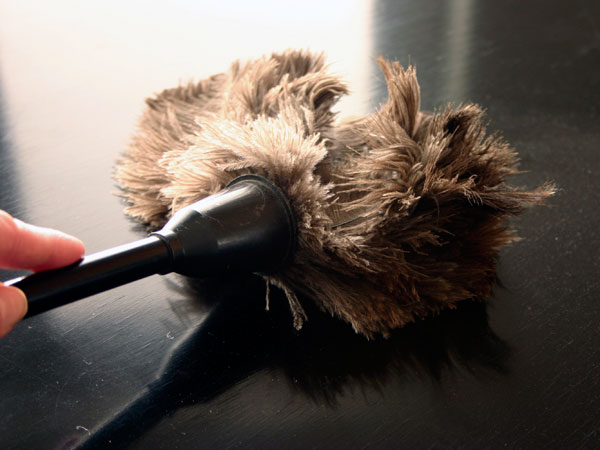You’re going to need more than a few feathers on a stick.
Sure, a feather duster may look fancy or even fun to use. But when tackling serious dust and dirt, skip the classic sweep — it’ll only move particles around, not pick them up. Instead, capture dust with a soft cloth dampened with water, microfiber dusters, or electrostatic dusters (like the Swiffer, which holds the Good Housekeeping Seal). For ceiling-to-floor cleaning (you should work from top down), a vacuum with multiple attachments is the most efficient tool. But for hard-to-reach spots or other probelm jobs, you need a more targeted strategy:
Electronics
Computers, TVs, DVD players, stereos, and printers are notorious dust magnets. Always unplug the equipment before cleaning. A gentle swipe with a microfiber cloth usually does the job, while a soft, long-handled brush will collect dust from crevices. Be sure to vacuum dust from around cords and vents because, along with pet hair, it can clog machines or outlets.
Curio cabinets
To get at dust trapped in tiny nooks and intricate carvings, use a clean natural-bristle paint or makeup brush, then wipe with a microfiber cloth.
Soft toys
Put beanbag critters, teddy bears, or fabric dolls into a large plastic bag with a cup of baking soda. Secure the top, then take outside and shake well. The baking soda and static will draw out the soil and dust. Remove items one at a time, shake off the clumps of baking soda, and vacuum the rest using a brush attachment.
Behind the stove and refrigerator
Over time, crumbs, grease, and other debris accumulate in these areas, providing a food source for insects and other pests. If possible, move the appliance out from the wall and unplug. Use a long-handled, slightly damp sponge mop to lift dust from the back of the appliance, then wipe floor and walls with hot soapy water.
Vents
Remove heavy dust from ceiling, floor, or appliance vents with a soft-brush vacuum attachment or electrostatic mop, then dampen a microfiber cloth and wipe the surface. Rinse removable, washable air-conditioning filters well in hot soapy water and air-dry before reinstalling.
Ceiling fans
Place newspaper or a drop cloth under a ceiling fan. Turn off the power source, then get on a step stool. Use damp paper towels to wipe greasy dust from the casing and a soft-bristle brush dampened with a mild cleanser to loosen the dust on the blades; rinse with a damp paper towel.
All rights reserved to the initial publisher for Good Housekeeping.
Collected and published by Arms &McGregor International Realty® editorial team. Get in touched with us at [email protected]

